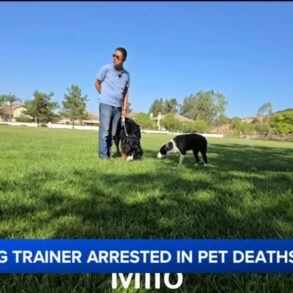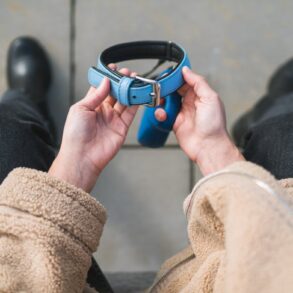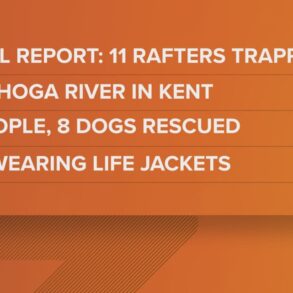Annoel Krider poses with her dog Molly. (Provided photo)
We have a rescue dog that has behavioral issues, specifically termed as “reactive.” When we brought her home not realizing the problems she had, we considered taking her back, but we didn’t.
We are not strangers to dogs with issues. It’s just that we knew what lay ahead and weren’t sure if we were up to it … again. However, we adopted her, brought her into our home, held her, introduced her to our other dog and cat and she reciprocated with affection and trust so we committed to her life with ours. Plus, we were falling a little in love.
It was eminently clear that the solution to Poppy’s fears was training, but we needed help.
I discovered a dog training program on the internet, and before I knew it other training seminars and workshops started popping up everywhere. Enticing comments about how to stop your dog from lunging at other dogs in 10 minutes and why you don’t need treats to train your dog. No treats? I don’t know about you, but I’m guilty of what dog trainers everywhere discourage and that’s when my noncompliant dog doesn’t come to me I use the word “cookies” instead of “come.” The cookies word wins out every time.
We are on dog number six, and most of them have attended, to some degree, dog school. Three of them have learned some important skills at the Adirondack High Peaks Dog Training Club in Saranac Lake. Hopefully, our present dog, Poppy, will be the fourth.
Although I have pursued a couple training websites, there is nothing that tops that actual hands on, in-person training. Dogs hanging out with other dogs, teacher viewing these interactions … teacher viewing you and what negative signals you might be presenting that get your dog reacting adversely. In-person dog training is, I believe, the most effective source of helpful information setting you and your dog’s relationship off to the right start.
Our first dog, Laddie, would rip my running pants to shreds trying to herd me on our morning runs when he was a puppy. That segued into herding moving vehicles by attempting to stop them by biting at the front tires. My heart stopped on many occasions. We thought how cool it would be to walk and run him without a leash; however, when I finally took Laddie to dog school, the first lesson was teaching him how to walk on a leash, which he wasn’t remotely interested in doing.
Adirondack High Peaks Dog School guided me and my over-the-top Australian shepherd Laddie to the finale of receiving his AKC Good Citizen certificate. How proud we were of him. We then signed him up for agility, which of course a herding, high speed, energy to spare Australian shepherd would be perfect at. The class took place in a large barn with the entire agility course set up inside. But toward the end of the class — when all the dogs were off leash and wanting more action and less talk — Laddie decided to exit out the big barn door followed by a number of the other dog attendees. OK, so you don’t want to do agility?
Then there was Ms. Molly Malone, a big black furry rescue dog who loved people but had a tendency to attack other dogs on our walks. Thankfully she never caused injury. Apparently, it was just her way of making a point in cementing the “who was in charge” scenario.
I know that dogs sense what’s going on in their humans and respond accordingly, and in Molly’s case, I think she often picked up on the concern I had of her reaction to other dogs. I had some theories why she became aggressive; nevertheless, it was apparent that it was time to take her to my local dog school.
They knew of her issue and helped me navigate Molly through the pack of dogs that were also in the beginning class. Because of their vast knowledge of dog behavior, I had a stress free and successful class. Molly graduated with flying colors.
I’ve read that dogs need to know who is in charge, and if it’s not the human being, then it’s the dog, and sometimes that leads to a stressful environment for the dog. He would much rather know what the daily schedule of events are that you, the human, put into place.
One of our present dogs, Addie, is a golden retriever, and when she was at that young age tearing up newspapers and shoes and running out of sight after flocks of birds on the beaches of Hilton Head, South Carolina, it was clear she needed some dog training. We were spending the winter in Hilton Head, so I took her to a dog trainer who was offering a class at PetSmart. One of the first things she said to the class was. I know you all don’t have smart and savvy golden retrievers, so listen carefully. The implication being that golden retrievers are smart and learn quickly. Well, I’m not entirely sure about that. Addie is 8 years old now, and to this day she pretends she doesn’t hear me when it doesn’t suit her mission at hand.
Clearly, I need to heed my own words. Training is important, and it’s something that doesn’t end with a class but a practice you have to continue throughout your dog’s life. There is also some unyielding DNA in dogs that have to be dealt with in creative ways. Laddie, my herding Aussie, still had the instinct to herd, so I secured a Frisbee, which was the only thing that stopped him from biting the front tire of a snow plow. Molly always wanted to protect me from other dogs so the solution was simply to walk her on a leash and find open spaces for her to run freely when no threat was in sight.
Not all instincts will be trained away, but with a little creativity and help from a good dog school life with your dog can be an exceptional journey.
This post was originally published on this site be sure to check out more of their content.









































